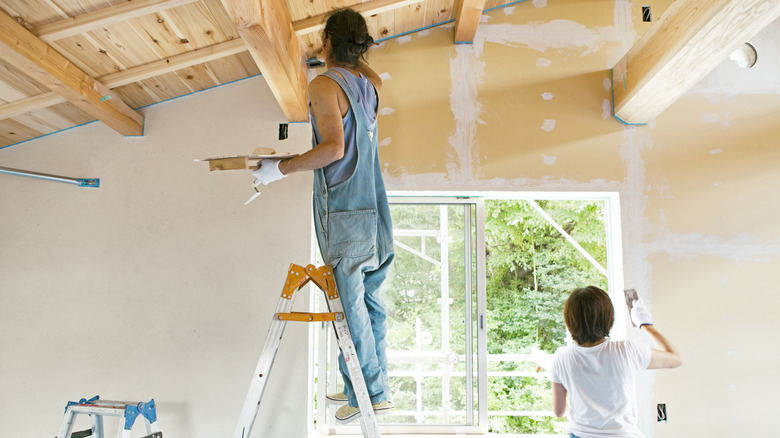Upgrade Bathroom Counters, Showers And More On A Budget With Plaster
If certain things in your bathroom are making it feel outdated, and you don't have room in your budget for a full-scale renovation, you may want to consider a type of plaster called microcement. It's a cement-based coating that can be applied to a variety of surfaces, including bathroom countertops, shower tiles, and even floors. Sold under many different brand names such as Concretta or Surecrete, it gives surfaces a gorgeous textured finish with lots of personality, lending an Old World, organic vibe similar to Venetian plaster. It's easy to apply, making it an excellent DIY solution that doesn't cost a lot and can take your bathroom from outdated to outstandingly beautiful.
Not only is microcement a great way to help cut the cost of your bathroom remodel, but it could even give mismatched bathroom fittings a seamless look by applying it to multiple surfaces. It comes in a variety of colors, so you can customize it according to your own aesthetic. Once it dries, it creates a waterproof, non-slip, and mildew-resistant finish. It's also resistant to stains and easy to wipe clean. While these can all be considered pros, it's important to consider the cons too. Namely, it can crack over time as your house settles and may need to be reapplied. It's also applied in a thin layer and, therefore, does not provide much insulation when used on the floor. Still, you can't deny the beauty it can bring to bathrooms or its affordable price point.
How to apply microcement to your bathroom surfaces
Ready to tackle this DIY project? Tape off any areas that need to be protected. If you're starting with a wood or another porous surface, apply a coat of primer first. You don't have to prime any tiled surfaces, though. Mix up the microcement powder in a large bucket with some water — you're aiming for a spreadable pancake batter-like consistency. Use a putty knife to scoop some of the mixture onto a trowel and begin spreading it evenly over the surface. If you want a lot of texture and movement, drag the trowel in various directions as you apply it. Let it dry completely, sand, and then apply a second coat. Before this layer dries, use a sponge to "wet sand" the plaster to even out any rough spots until you have a nice, smooth finish. Once dry, apply a topcoat to seal the surface.
If you want to create a custom look for your bathroom, you could experiment with using different tools to create different textures. For example, you could use a squeegee to create large sweeping areas of movement or a textured paint roller to create a raised texture that has a more uniform look. There are also various concrete stamping tools you could use to create certain patterns. Whatever type of texture you add, it's sure to create a beautiful finish that's both modern and timeless. Talk about a cheap and creative way to update your bathroom on a budget!
